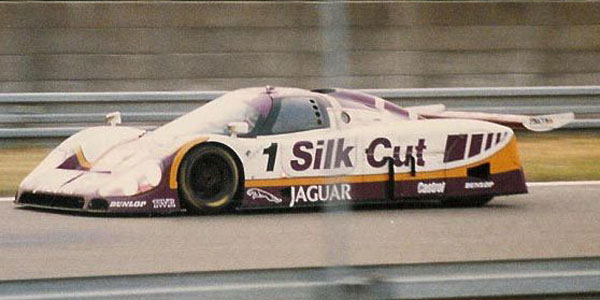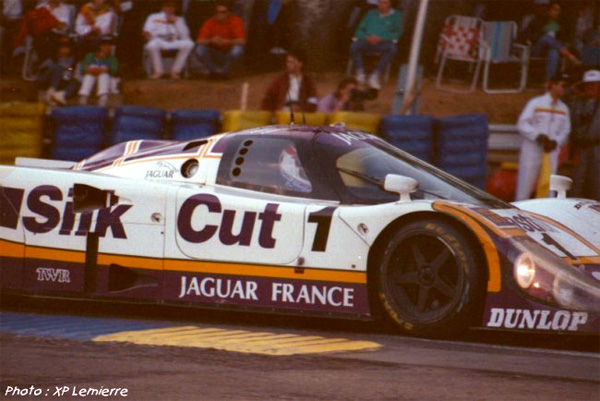|
|
26315 view(s)  Racing on both sides of the Pond Racing on both sides of the Pond
As the Group 44 effort faded at the end of 1987, Jaguar commissioned TWR to also campaign their latest XJR-9 in the IMSA GTP in 1988. Again there were only detail changes and one of both the XJR-6 and XJR-8 chassis were upgraded to join the new XJR-9s in the 1988 season.
The Castrol sponsored XJR-9s debuted at the 24 Hours of Daytona, with the car successfully taking the overall win.
However, throughout the rest of the IMSA Camel GTP season the XJR-9 was unable to gain another win until the final race of the season, meaning the team had to settle for 3rd in the constructor's championship.
Over in the World Sportscar Championship, the XJR-9 met with more success. Jaguar was able to take six victories, over the eleven race season and clinch another world championship.
1988 LM 24hrs, "Porsche" Copycat?
With the Le Mans 24 hrs being the pearl in the WSC, Jaguar took a page from Porsche's book in its attempt to secure all out victory.
Tom Walkinshaw Racing developed a special version, the XJR-9LM, specifically for this race.
No less than five cars, running Silk Cut sponsorship, were fielded at Le Mans. This was made possible by IMSA GTP effort and two cars were ran by the team that spent the rest of the season in North America.
During the race, the five Jaguars gradually fought their way to the top until the first car retired with transmission problems eight hours in the race. Eleven hours later a head gasket on the second car failed. All was not lost as Jan Lammers led the race in one of the three surviving examples. Tragedy almost struck when the car suffered from the same transmission problems as the first retiree, but Lammers noticed it in time and left the car in fourth gear to complete the race two minutes ahead of the fastest Porsche. If he had only changed gears once, the transmission would have died and with it the dream of Jaguar's sixth Le Mans win. Lammers took the win together with Andy Wallace and John Dumfries.
Jaguar's success at Le Mans marked the first time since 1980 that Porsche had not won Le Mans.
1989 IMSA/ WSC
For 1989, the XJR-9 was again campaigned in both IMSA Camel GTP and the World Sportscar Championship. However, the XJR-9 was by now dated, and in IMSA was being repeatedly beaten by Nissan, leaving the XJR-9 with only a single win on the season. This led to Jaguar introducing the XJR-10 midway through the season, which met with slightly better success having two wins on the season and usually placing higher then the XJR-9 it ran with. At the end of the season, Jaguar finished 2nd in the championship.
A similar story occurred in the World Sportscar Championship, with Jaguar not able to score a win at all over the entire season against the likes of Sauber-Mercedes. Again, midway through the season the XJR-11 was developed to replace the XJR-9, although both finished out the season. This disappointment led to Jaguar finishing 4th in the teams championship that season.
1989 LM 24hrs 
This time Jaguar fielded 4 LM "specials for the June race looking extremely similar to the 88 cars. The main dorsal airintake had been moved to the sides, the low drag rear wing was even smaller and placed lower and more to the back. Underneath there were now 18inch wheels, but the biggest innovation was the use off telemetry so Tom could keep an eye on the condition of the now 7 liter V12.
The cars were fast in practice, had the highets top speed and as the race started soon nested themselves at the head of the filed
Alas this is where all comparisation with the previous year ended. Throughout the race the Jags were plagued by nasty glitches, tyres turned on their rims causing excessive vibrations, which caused the exhaust manifold to crack. Gearboxes started to fail, in other words drama.
This time Covetry had to bow to the might of Bavarian grunt and Swiss precision.
Many years after the replacement of the XJR-9, TWR would use leftover chassis for the development of the Jaguar XJR-15 supercar and spec-racer.
Dimensions of the Jaguar XJR 9 :
Length: 4830mm, Width: 2000mm, Height: N/A, Wheelbase: 2710 mm
Sources:Wouter Melissen, www.ultimatecarpage.com , Wikipedia Jaguar XJR 9, 24 heures du Mans 1988, editions Acla
|
Models for Jaguar XJR 9
 |
| Manufacturer |
Model |
Scale |
Dimensions (LxWxH) |
Wheelbase |
Front spur |
Rear spur |
| Hasegawa |
XJR-9LM |
1/24 |
99.9x82.0x40.8 |
99.9 |
79.5 |
81.8 |
| Hasegawa |
XJR-9 sprint Castrol |
1/24 |
99.9x82.0x40.8 |
99.9 |
79.5 |
81.8 |
| Tamiya |
1988 XJR-9LM |
1/24 |
99.9x82.2x41.0 |
99.9 |
81.0 |
82.2 |
|

